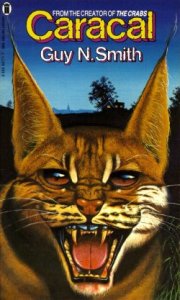
First published back in December of 1980, Guy N Smith’s early man-eater on the rampage novel entitled ‘Caracal’ is a classic example for so many aspects of the great scribblers well documented profile.
DLS Synopsis:
In the attic of a crammed and somewhat dilapidated
hippy commune named ‘Pentre’ in the Radnor hills of Mid Wales by the
Shropshire border, the Pakistani illegal-immigrant, Bilal, sits nurturing his young pet caracal . The other residents of the commune are far from happy about the presence of an illegal immigrant in their abode, especially one with such an exotic pet. Lester Hoyle, the self-proclaimed leader of the commune puts himself forward as the disgruntled voice of the commune regarding this whole situation.
Whilst the other residents of the commune decide what to do about Bilal, the Pakistani knocks together a temporary cage for his pet caracal out of an old broken-down poultry-house nestled away at the bottom of their overgrown back garden. However, after not being fed one night, the caracal breaks free of its poorly secured home and explores the local area, hunting for food.
The following morning the caracal returns, wounded from an illegal gin-trap set by the local gamekeeper, Melvyn Hughes. Bilal and one of the commune’s more caring residents named Wendy set to administering first-aid to the feline’s paw. However, the caracal is beginning to draw attention from the nearby farmers with the puzzling discoveries of various skinned and consumed remains of their livestock, from the caracal's frequent night-time hunting excursions.
When the first local child is killed by the caracal, Pentre’s residents feel that they have the victim’s blood on their hands. By now the caracal (now affectionately named ‘King’) is as big as a full grown fox, with savage claws and a developing taste for blood. Soon enough more young children become further victims to the prowling caracal, who has now lost all of its domesticity.
The caracal turns on Bilal, killing him with its lethal claws before escaping off into the surrounding woodland. By now the authorities have organised a massive hunt for the beast dubbed the ‘Black Beast of Radnor’. Struggling writer Wes Lansdale is among those from the commune that feels in some way responsible for the caracal still being at large. Together with animal expert Professor Colin Rutter, Lansdale hopes to bring these savage killings to an end; whether by capturing the caracal or by killing it.
The hunt is on. But who is the hunter and who is the hunted...
DLS Review:
The tale begins with an unusually slow pace for one of Smith’s novels. The premise of how the caracal has come to be located in the rural Welsh landscape is first set down and the many different characters that will play their parts within the unfolding storyline are established and gradually built upon. The principal character of Wes Lansdale shows signs of being moulded from the author’s own life, offering a mildly autobiographical viewpoint for the reader to glimpse. Moreover, the novel begins to fall into the usual familiar territory for the writer, with his views on hunting and gun ownership once again finding their voice within the unfolding storyline.
The caracal may at first glance seem to be somewhat of a feeble foe compared with many other similarly wild animals that Smith could have been used. However, the author proves that this is not the case, cranking up the savagery of the creature until it is nothing but a bloodthirsty, lightning-fast, killing machine.
The resulting bloodshed delivers all the pulpy gore you would expect from a piece of Guy N Smith fiction. The victims are picked off, chapter by chapter; each one succumbing to the savage claws in a graphic show of bloodspill. Smith plays with the reader’s inherent sympathies, bringing young children to the front of the victims chosen by the caracal.
However, Smith manages to cleverly inject an almost equal sympathy for the caracal itself, having been brought to these new surroundings against its will and is now merely following its natural instincts of hunting prey for survival. Questions are subtly raised and ideas behind hunting and its justification pondered. Indeed, Smith’s obvious love for wild animals is brought to the very forefront of the novel, most notably within the characters’ dialogue time and time again.
The victims continue to mount up, until Smith finally wraps up the fate of the caracal, leaving conflicting emotions in the wake of a provocative and entertaining pulp horror read. The characterisation remains one of the most developed and full-bodied of his novels. The storyline is unpredictable in its meandering nature, leaving the reader gripped with the turn of each page.
Utilising the story of a wild man-eater on the loose within the rural areas of the UK, the tale successfully taps in to the age-old urban legends that have become an almost mythical piece of our heritage. The notion is far from a new one, but one that Smith has utilised well and produced an altogether well rounded and entertaining piece of fiction from.
Smith later returned with a very similar story premise, with the novel ‘Maneater’ (2009) which saw a wounded and desperate leopard on the loose. Although there are many similarities in the premise of the two novels, they both follow their own storylines, and as such, can be clearly set apart from each other.
The novel runs for a total of 172 pages.
© DLS Reviews







